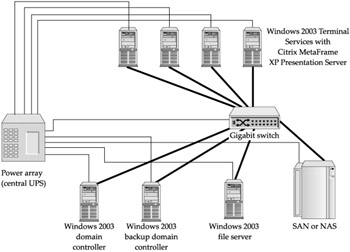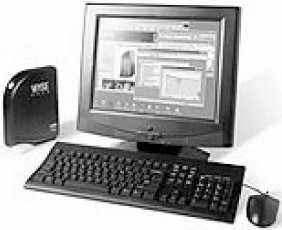Components of an Enterprise SBC Architecture
|
An enterprise SBC architecture has three major components: one or more data centers, clients (at both the headquarters and remote offices, and possibly at home offices), and wide area network connectivity.
Data Center
The data center is the heart of enterprise SBC architecture. Not only are all SBC applications and corresponding data hosted in the data center, but 100 percent of the hosted application processing occurs within the data center as well. The major data center components include the MetaFrame XP Presentation Server server farm, file servers and/or network attached storage (NAS) or storage area network (SAN) systems, other application servers, host systems, a fast server backbone, and a backup system. Figure 1-4 shows a sample on-demand enterprise data center.

Figure 1-4: A typical on-demand enterprise data center
MetaFrame XP Presentation Server Farm
Application execution occurs on the servers running Microsoft 2003 Terminal Services and Citrix MetaFrame XP Presentation Server. Because of the high resource demands made on these servers as well as the challenges involved in configuring them to run multiple applications without DLL conflicts or other problems, it is prudent to utilize at least two load-balanced servers at all times. The MetaFrame XP Presentation Server load manager component is recommended over other solutions because of its ability to share server resources while providing good redundancy. If a user should be disconnected from the server, when she logs back in, the load manager will find the server in the farm where the user's session is running and reconnect her to it.
| Note | Data is never stored on the MetaFrame XP Presentation Servers. Data is always stored on back-end file servers, application servers, NAS, or SAN systems. |
File Servers
Typical file servers in an SBC environment run a network operating system such as Windows Server 2003 or Novell. The servers feed files to the MetaFrame XP Presentation Server farm, maintain directory services, store user profiles, and sometimes handle printing functions. For larger SBC implementations, a separate high-end print server should be dedicated to handle the printing function, as described in Chapter 18.
Storage Area Networks and Network Attached Storage Systems
In some SBC architectures, a storage area network (SAN) or network attached storage (NAS) will supplement the file servers, allowing organizations to store and access large amounts of data more efficiently. In others, the SAN or NAS may take the place of clustered back-end file servers and still provide mainframe-like reliability and redundancy along with superior performance and scalability. The best solution for your organization depends on both your application environment and user file-sharing needs. This topic is discussed more thoroughly in Chapter 5.
Application Servers
The rule of thumb is to have your MetaFrame XP Presentation Server server farm located wherever your data is stored. E-mail servers, SQL database servers, and all other application servers ideally should be located within the data center. At a minimum, they must be connected to the file servers and MetaFrame XP Presentation Server server farm through a fast backbone. The MetaFrame XP Presentation Server server farm hosts virtual Windows Server 2003 desktops (looking just like Windows XP desktops) for users throughout the organization (assuming they are not publishing the applications to a browser). While users see only screen prints of the applications at their workstations or Windows terminals, real data is traveling back and forth between the MetaFrame XP Presentation Server server farm and the file servers and application servers. An inadequate server backbone will cause an immediate data traffic jam that will result in performance degradation for all users. Application servers, including print servers, are covered more thoroughly in Chapters 5, 12, 19, and in Appendix A.
Host Systems
Mainframe and minicomputer systems should be housed in the data center where they can be managed along with the Terminal Services hosting infrastructure. This enables organizations to leverage both their data center environmental resources and their support staffs. MetaFrame Presentation Server for UNIX is covered in Chapter 12.
The Server Backbone
A fast backbone should connect the MetaFrame XP Presentation Server server farm, the back-end file servers, and all other servers in the data center. This backbone should be either switched 100MB Ethernet, FDDI, ATM, or switched gigabit Ethernet. As with all data-center components, a redundant server backbone is desirable. This topic is discussed more thoroughly in Chapter 6.
The Backup System
A backup system should enable automatic backups of all servers. Tapes should be rotated offsite. Remote electronic data backups by companies such as Evault and Iron Mountain can add still another layer of redundant data protection. This topic is discussed more thoroughly in Chapter 19.
Security
SBC enables enhanced security by centralizing data and network access. It is still essential to design and implement an enterprise security strategy. Citrix MetaFrame Secure Access Manager (another product in the MetaFrame Access Suite), third-party applications, firewalls, identity management, and authentication are some of the measures to consider. This topic is discussed more thoroughly in Chapter 8.
The Number of Data Centers
The number of data centers utilized depends upon many variables, including bandwidth availability and business and geographic segregation. For instance, if a corporation's European operations utilize entirely different software than U.S. divisions, and bandwidth is expensive between the continents, separate data centers make more sense than a single, central data center. In general, though, savings will be greater when data centers are consolidated. This is a result of the economies of scale realized by centralizing as much SBC hardware, software, and administration labor as possible. This topic is covered in Chapter 5.
Disaster Recovery/Business Continuity
A single data center, despite internal redundancy, leaves a corporation's headquarters and remote operations vulnerable to a single point of failure. One strategy for mitigating this risk is to utilize multiple data centers with fail-over capabilities. Another strategy is to use one corporate data center, and then contract with a disaster recovery provider to maintain a geographically distant facility that mirrors the MetaFrame XP Presentation Server server farm and other crucial components of the corporate data center. This topic is discussed more thoroughly in Chapter 19.
Clients
SBC users often work at headquarters, at remote offices, and at home. At times, they are in hotels or at customer sites. They utilize PCs, laptops, Windows terminals, tablets, and handheld devices. Increasingly, they use specialty display devices that incorporate the Citrix ICA protocol to take advantage of the inexpensive computing capabilities provided by SBC. Clients are covered in Chapter 7.
Personal Computers
PC users can access applications hosted at the data center in multiple ways. When PCs have a full-time connection to the data center (through Ethernet frame relay or the Internet), MetaFrame XP Presentation Server enables application publishing to either a Windows desktop or a browser. Employees see icons of both local applications (if any) and applications hosted on the MetaFrame XP Presentation Server server farm to which they have access. These icons can be part of their startup file, and it is not obvious whether they represent local applications or applications hosted by the server farm. Users who run all applications from the server farm may receive their entire desktop as a published application. The lower the number of local applications accessed by a PC user, the lower the administration costs. This topic is discussed more thoroughly in Chapters 4 and 15.
Laptops
Laptops typically run local applications when disconnected from the network. When connected to the network by a dial-up or wireless WAN connection, laptop users commonly launch a MetaFrame XP session. Extra training helps ensure laptop users do not confuse local applications with hosted applications. We have found that many employees of companies with SBC environments end up abandoning laptops except when on planes or in motels since they find it less cumbersome to use a PC or Windows terminal at both the office and home.
Windows Terminals
Nearly every major PC manufacturer, including IBM, Hewlett-Packard, and Dell, now makes Windows terminals. Many specialty companies, including Maxspeed, Neoware, and market leader, Wyse Technology, focus on building Windows terminals. Figure 1-5 shows one of the many models of Wyse Windows terminals. Windows terminals are typically display devices with no moving parts of any kind. They utilize a thinned-down version of Linux, Windows CE, or an embedded version of Windows XP. Windows terminals typically have built-in local-host emulation and, sometimes, browsing in order to offload these character display functions from the MetaFrame XP Presentation Server server farm. Some manufacturers, such as Wyse, also have wireless and tablet devices that enable users to access their complete desktop remotely.

Figure 1-5: A Wyse WinTerm Windows terminal
Because Windows terminals often have mean times between failure measured in decades, their maintenance expense is extremely low. If a Windows terminal does fail, IT simply delivers a replacement unit to the user. The user plugs in the Windows terminal, turns it on, and sees his or her desktop. Unlike PCs, Windows terminals do not allow users to destroy their unit configuration by loading games, screensavers, or other potentially damaging software. This makes the Windows terminal an ideal device for telecommuters with families that like to share personal computers at home. It also significantly lowers the cost of supporting telecommuters. Windows terminals are discussed more thoroughly in Chapter 7.
Using a Browser Interface
As the Internet's pervasiveness continues to grow, more organizations prefer to utilize browser interfaces. With the web interface component of MetaFrame XP Presentation Server, organizations can use their browser to launch published applications from the server farm. The web interface component also enables an organization's customers and suppliers to launch authorized applications through a browser. Different users with different logins will see different applications. This topic is discussed more thoroughly in Chapter 16.
Wide Area Network Connectivity
MetaFrame XP Presentation Server requires between 10KB and 20KB of bandwidth per user session. This does not include additional bandwidth for large print jobs or for downloading or uploading files to and from a fat-client PC. When remote office applications are hosted at a corporate data center, they are completely dependent upon access to the MetaFrame XP Presentation Servers for all of their processing. An SBC architecture must include both adequate and reliable bandwidth connections along with redundant contingencies.
A frame relay circuit is the most popular connectivity method to multiple remote offices, though organizations increasingly utilize virtual private networks or straight Internet connectivity. Telecommuters, in particular, are using inexpensive fixed-fee Internet accounts to connect to corporate data centers. Bandwidth management is often desirable in order to prioritize ICA traffic. Bandwidth management devices from manufacturers such as Packeteer will prevent a user's large print job or file download, for example, from killing performance for the remaining users at a remote office. This topic is discussed more thoroughly in Chapters 6 and 17.
It sometimes makes more economic sense for regional headquarters and large remote offices to utilize their own MetaFrame XP Presentation Server server farms. This may also be true if the office uses software applications largely independent of, and different from, those employed at headquarters. Even in these scenarios, though, a common corporate database application, such as an ERP package, can still run off the MetaFrame XP Presentation Servers at the corporate data center. The regional offices can access this application by running the corporate ICA session within their own ICA session. This topic is discussed more thoroughly in Chapter 12.
|
EAN: 2147483647
Pages: 158